Analyzing Health and Social Care Innovation During COVID-19 Crisis
VerifiedAdded on 2023/06/15
|12
|3416
|348
Report
AI Summary
This report examines the impact of the COVID-19 pandemic on health and social care, focusing on the challenges and changes in innovation within the sector. It highlights the negative impacts of the coronavirus outbreak, particularly on healthcare workers, including increased risks, job insecurity, and lack of PPE. The report analyzes the functions of the NHS and NHS England in relation to stakeholders during the pandemic, emphasizing the importance of organizational culture and structural modifications. It also explores the effects on career prospects, the role of employment conditions, and the need for measures to support care professionals. The report concludes by underscoring the importance of adapting and innovating in healthcare to address the ongoing challenges posed by the pandemic.
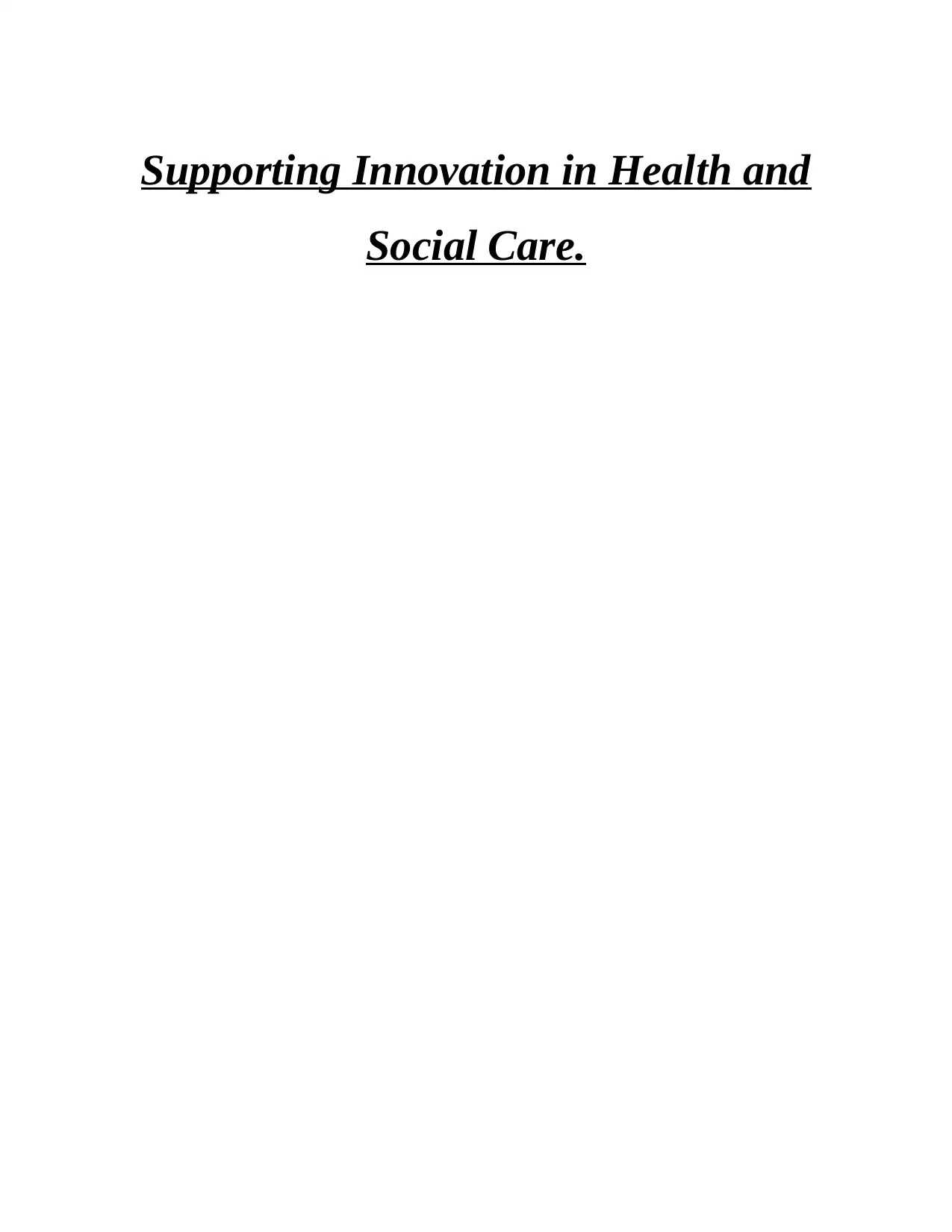
Supporting Innovation in Health and
Social Care.
Social Care.
Paraphrase This Document
Need a fresh take? Get an instant paraphrase of this document with our AI Paraphraser
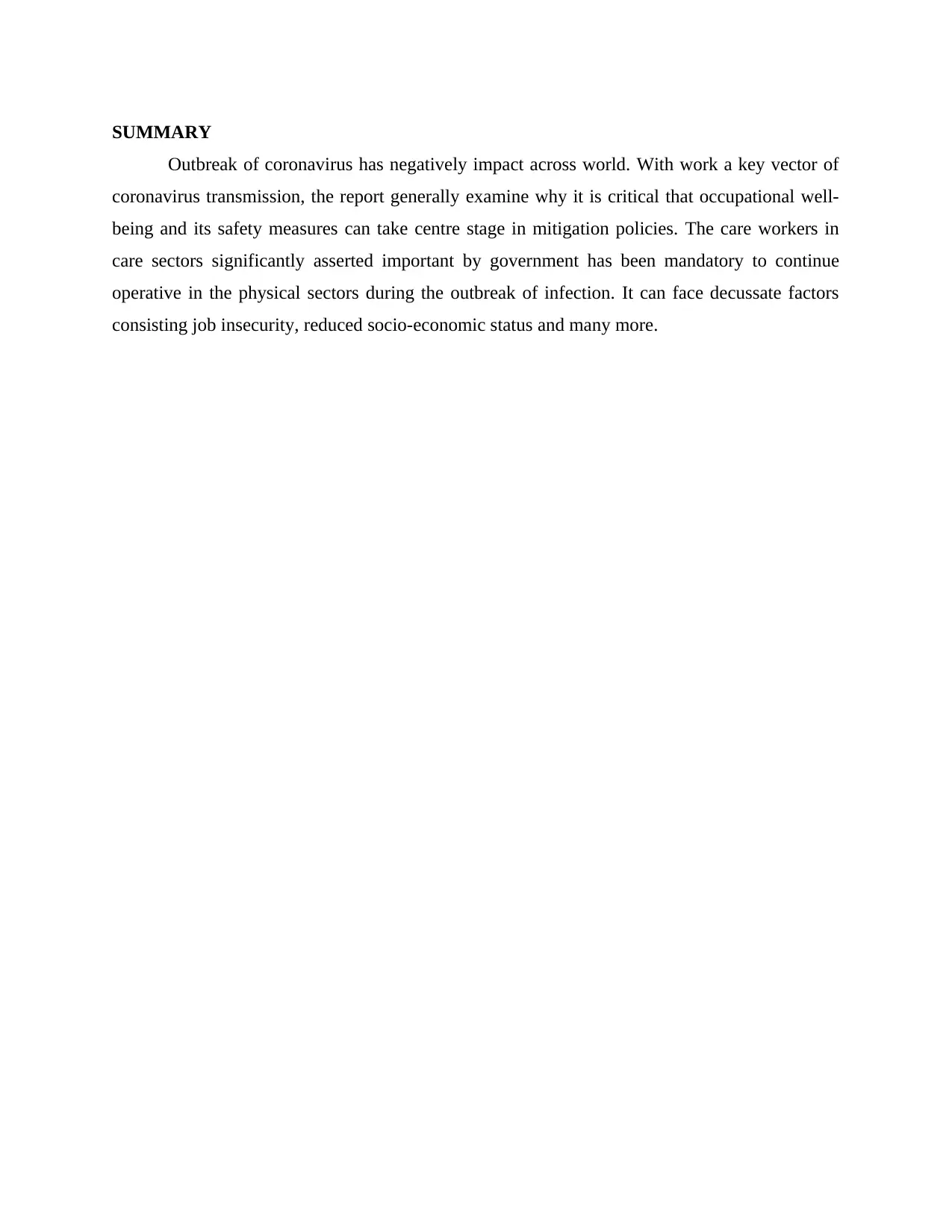
SUMMARY
Outbreak of coronavirus has negatively impact across world. With work a key vector of
coronavirus transmission, the report generally examine why it is critical that occupational well-
being and its safety measures can take centre stage in mitigation policies. The care workers in
care sectors significantly asserted important by government has been mandatory to continue
operative in the physical sectors during the outbreak of infection. It can face decussate factors
consisting job insecurity, reduced socio-economic status and many more.
Outbreak of coronavirus has negatively impact across world. With work a key vector of
coronavirus transmission, the report generally examine why it is critical that occupational well-
being and its safety measures can take centre stage in mitigation policies. The care workers in
care sectors significantly asserted important by government has been mandatory to continue
operative in the physical sectors during the outbreak of infection. It can face decussate factors
consisting job insecurity, reduced socio-economic status and many more.
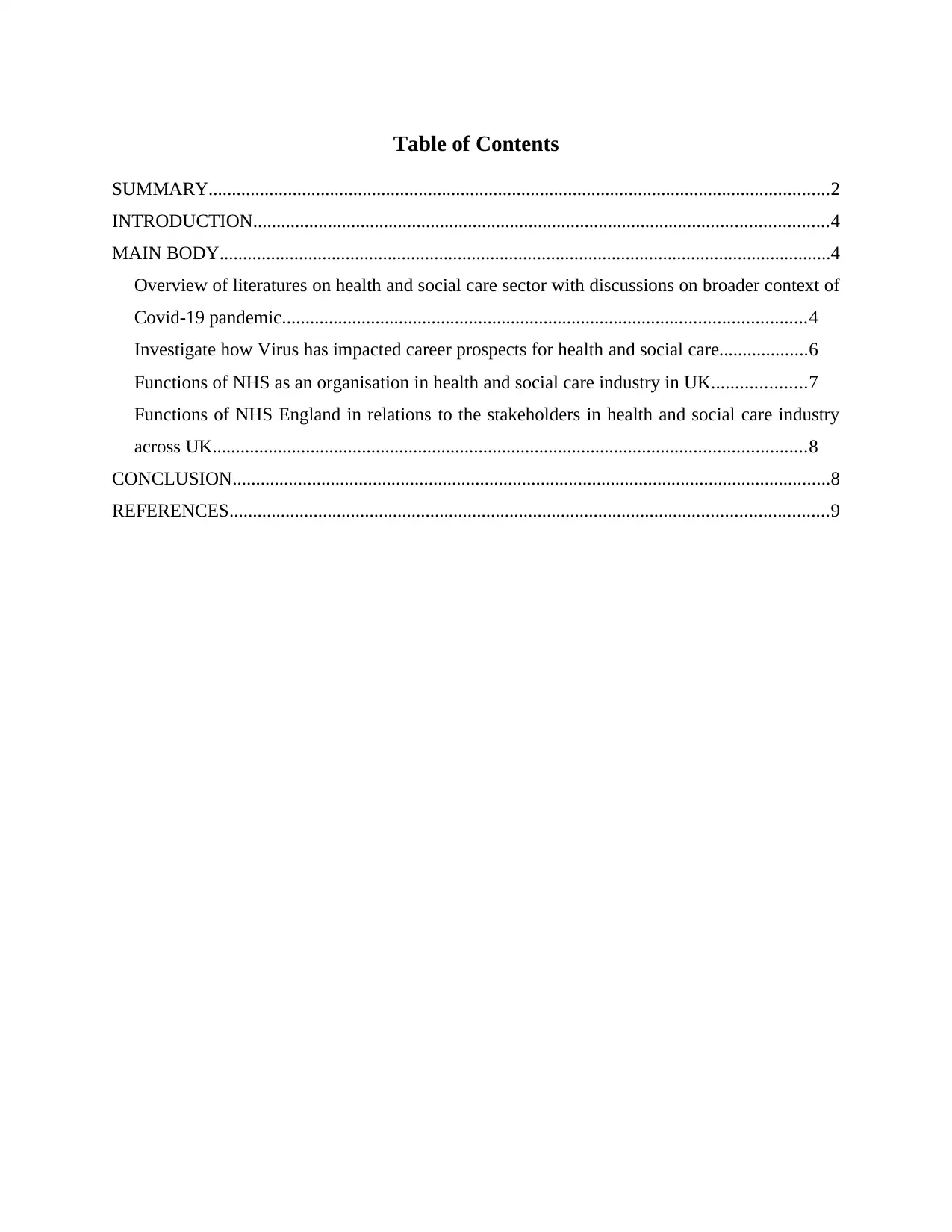
Table of Contents
SUMMARY.....................................................................................................................................2
INTRODUCTION...........................................................................................................................4
MAIN BODY...................................................................................................................................4
Overview of literatures on health and social care sector with discussions on broader context of
Covid-19 pandemic................................................................................................................4
Investigate how Virus has impacted career prospects for health and social care...................6
Functions of NHS as an organisation in health and social care industry in UK....................7
Functions of NHS England in relations to the stakeholders in health and social care industry
across UK...............................................................................................................................8
CONCLUSION................................................................................................................................8
REFERENCES................................................................................................................................9
SUMMARY.....................................................................................................................................2
INTRODUCTION...........................................................................................................................4
MAIN BODY...................................................................................................................................4
Overview of literatures on health and social care sector with discussions on broader context of
Covid-19 pandemic................................................................................................................4
Investigate how Virus has impacted career prospects for health and social care...................6
Functions of NHS as an organisation in health and social care industry in UK....................7
Functions of NHS England in relations to the stakeholders in health and social care industry
across UK...............................................................................................................................8
CONCLUSION................................................................................................................................8
REFERENCES................................................................................................................................9
⊘ This is a preview!⊘
Do you want full access?
Subscribe today to unlock all pages.

Trusted by 1+ million students worldwide
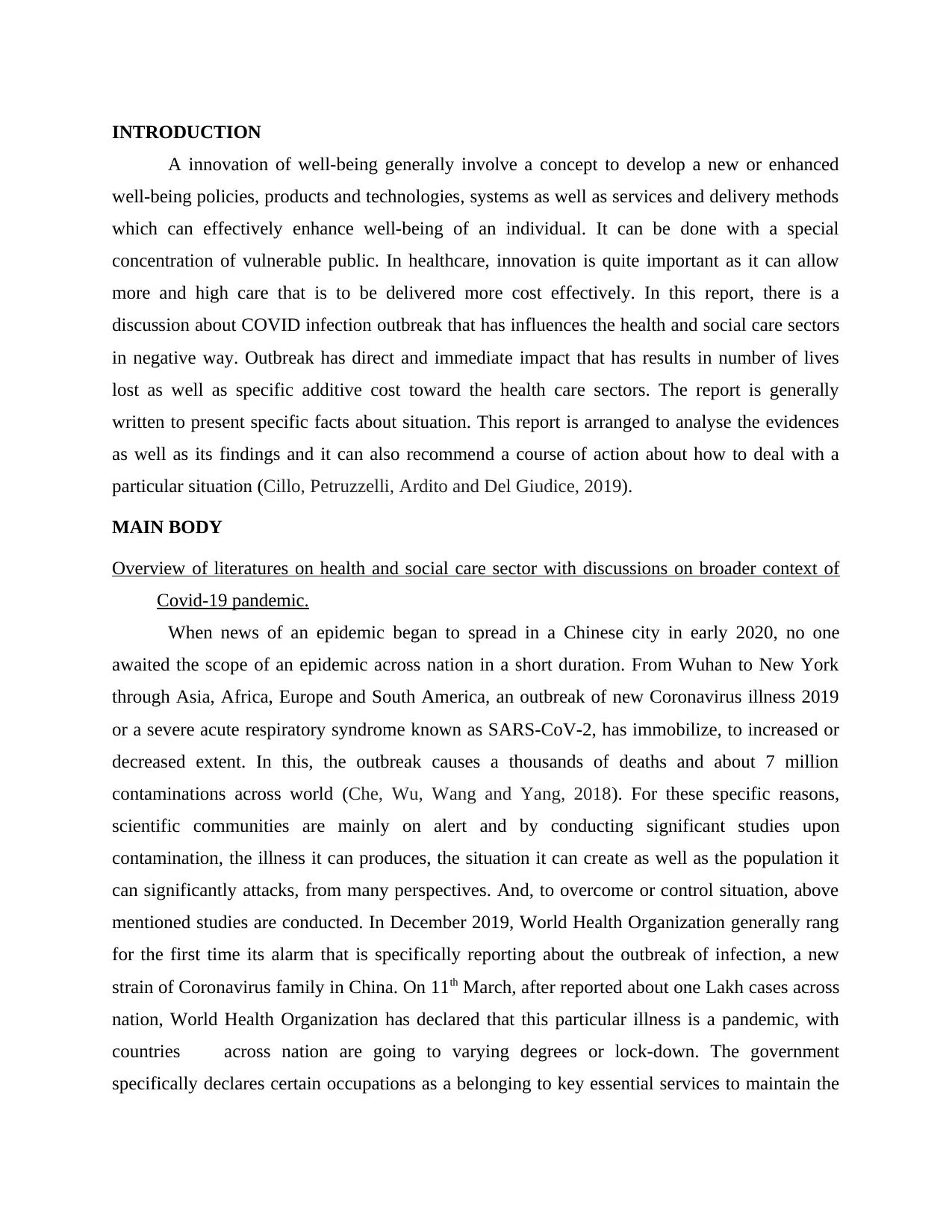
INTRODUCTION
A innovation of well-being generally involve a concept to develop a new or enhanced
well-being policies, products and technologies, systems as well as services and delivery methods
which can effectively enhance well-being of an individual. It can be done with a special
concentration of vulnerable public. In healthcare, innovation is quite important as it can allow
more and high care that is to be delivered more cost effectively. In this report, there is a
discussion about COVID infection outbreak that has influences the health and social care sectors
in negative way. Outbreak has direct and immediate impact that has results in number of lives
lost as well as specific additive cost toward the health care sectors. The report is generally
written to present specific facts about situation. This report is arranged to analyse the evidences
as well as its findings and it can also recommend a course of action about how to deal with a
particular situation (Cillo, Petruzzelli, Ardito and Del Giudice, 2019).
MAIN BODY
Overview of literatures on health and social care sector with discussions on broader context of
Covid-19 pandemic.
When news of an epidemic began to spread in a Chinese city in early 2020, no one
awaited the scope of an epidemic across nation in a short duration. From Wuhan to New York
through Asia, Africa, Europe and South America, an outbreak of new Coronavirus illness 2019
or a severe acute respiratory syndrome known as SARS-CoV-2, has immobilize, to increased or
decreased extent. In this, the outbreak causes a thousands of deaths and about 7 million
contaminations across world (Che, Wu, Wang and Yang, 2018). For these specific reasons,
scientific communities are mainly on alert and by conducting significant studies upon
contamination, the illness it can produces, the situation it can create as well as the population it
can significantly attacks, from many perspectives. And, to overcome or control situation, above
mentioned studies are conducted. In December 2019, World Health Organization generally rang
for the first time its alarm that is specifically reporting about the outbreak of infection, a new
strain of Coronavirus family in China. On 11th March, after reported about one Lakh cases across
nation, World Health Organization has declared that this particular illness is a pandemic, with
countries across nation are going to varying degrees or lock-down. The government
specifically declares certain occupations as a belonging to key essential services to maintain the
A innovation of well-being generally involve a concept to develop a new or enhanced
well-being policies, products and technologies, systems as well as services and delivery methods
which can effectively enhance well-being of an individual. It can be done with a special
concentration of vulnerable public. In healthcare, innovation is quite important as it can allow
more and high care that is to be delivered more cost effectively. In this report, there is a
discussion about COVID infection outbreak that has influences the health and social care sectors
in negative way. Outbreak has direct and immediate impact that has results in number of lives
lost as well as specific additive cost toward the health care sectors. The report is generally
written to present specific facts about situation. This report is arranged to analyse the evidences
as well as its findings and it can also recommend a course of action about how to deal with a
particular situation (Cillo, Petruzzelli, Ardito and Del Giudice, 2019).
MAIN BODY
Overview of literatures on health and social care sector with discussions on broader context of
Covid-19 pandemic.
When news of an epidemic began to spread in a Chinese city in early 2020, no one
awaited the scope of an epidemic across nation in a short duration. From Wuhan to New York
through Asia, Africa, Europe and South America, an outbreak of new Coronavirus illness 2019
or a severe acute respiratory syndrome known as SARS-CoV-2, has immobilize, to increased or
decreased extent. In this, the outbreak causes a thousands of deaths and about 7 million
contaminations across world (Che, Wu, Wang and Yang, 2018). For these specific reasons,
scientific communities are mainly on alert and by conducting significant studies upon
contamination, the illness it can produces, the situation it can create as well as the population it
can significantly attacks, from many perspectives. And, to overcome or control situation, above
mentioned studies are conducted. In December 2019, World Health Organization generally rang
for the first time its alarm that is specifically reporting about the outbreak of infection, a new
strain of Coronavirus family in China. On 11th March, after reported about one Lakh cases across
nation, World Health Organization has declared that this particular illness is a pandemic, with
countries across nation are going to varying degrees or lock-down. The government
specifically declares certain occupations as a belonging to key essential services to maintain the
Paraphrase This Document
Need a fresh take? Get an instant paraphrase of this document with our AI Paraphraser
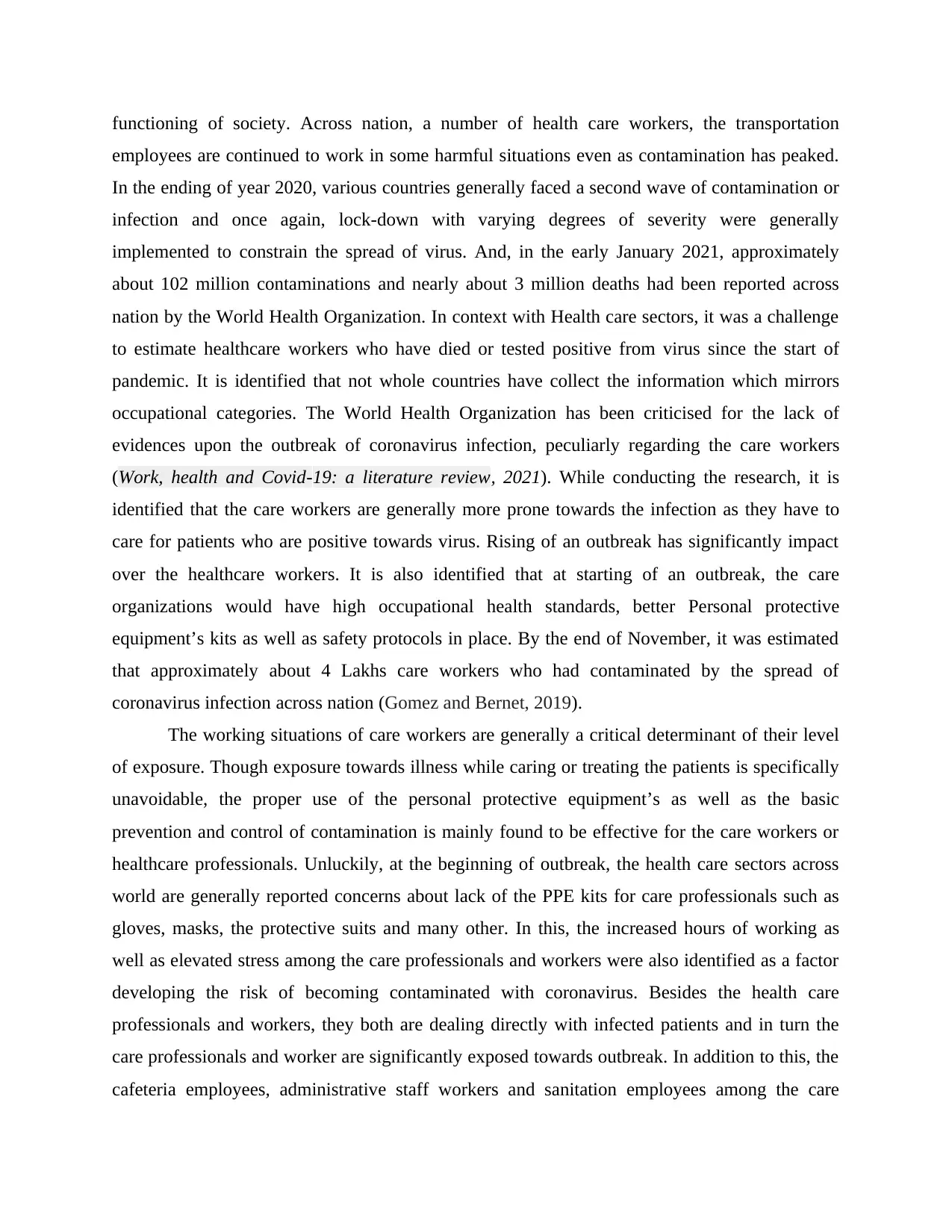
functioning of society. Across nation, a number of health care workers, the transportation
employees are continued to work in some harmful situations even as contamination has peaked.
In the ending of year 2020, various countries generally faced a second wave of contamination or
infection and once again, lock-down with varying degrees of severity were generally
implemented to constrain the spread of virus. And, in the early January 2021, approximately
about 102 million contaminations and nearly about 3 million deaths had been reported across
nation by the World Health Organization. In context with Health care sectors, it was a challenge
to estimate healthcare workers who have died or tested positive from virus since the start of
pandemic. It is identified that not whole countries have collect the information which mirrors
occupational categories. The World Health Organization has been criticised for the lack of
evidences upon the outbreak of coronavirus infection, peculiarly regarding the care workers
(Work, health and Covid-19: a literature review, 2021). While conducting the research, it is
identified that the care workers are generally more prone towards the infection as they have to
care for patients who are positive towards virus. Rising of an outbreak has significantly impact
over the healthcare workers. It is also identified that at starting of an outbreak, the care
organizations would have high occupational health standards, better Personal protective
equipment’s kits as well as safety protocols in place. By the end of November, it was estimated
that approximately about 4 Lakhs care workers who had contaminated by the spread of
coronavirus infection across nation (Gomez and Bernet, 2019).
The working situations of care workers are generally a critical determinant of their level
of exposure. Though exposure towards illness while caring or treating the patients is specifically
unavoidable, the proper use of the personal protective equipment’s as well as the basic
prevention and control of contamination is mainly found to be effective for the care workers or
healthcare professionals. Unluckily, at the beginning of outbreak, the health care sectors across
world are generally reported concerns about lack of the PPE kits for care professionals such as
gloves, masks, the protective suits and many other. In this, the increased hours of working as
well as elevated stress among the care professionals and workers were also identified as a factor
developing the risk of becoming contaminated with coronavirus. Besides the health care
professionals and workers, they both are dealing directly with infected patients and in turn the
care professionals and worker are significantly exposed towards outbreak. In addition to this, the
cafeteria employees, administrative staff workers and sanitation employees among the care
employees are continued to work in some harmful situations even as contamination has peaked.
In the ending of year 2020, various countries generally faced a second wave of contamination or
infection and once again, lock-down with varying degrees of severity were generally
implemented to constrain the spread of virus. And, in the early January 2021, approximately
about 102 million contaminations and nearly about 3 million deaths had been reported across
nation by the World Health Organization. In context with Health care sectors, it was a challenge
to estimate healthcare workers who have died or tested positive from virus since the start of
pandemic. It is identified that not whole countries have collect the information which mirrors
occupational categories. The World Health Organization has been criticised for the lack of
evidences upon the outbreak of coronavirus infection, peculiarly regarding the care workers
(Work, health and Covid-19: a literature review, 2021). While conducting the research, it is
identified that the care workers are generally more prone towards the infection as they have to
care for patients who are positive towards virus. Rising of an outbreak has significantly impact
over the healthcare workers. It is also identified that at starting of an outbreak, the care
organizations would have high occupational health standards, better Personal protective
equipment’s kits as well as safety protocols in place. By the end of November, it was estimated
that approximately about 4 Lakhs care workers who had contaminated by the spread of
coronavirus infection across nation (Gomez and Bernet, 2019).
The working situations of care workers are generally a critical determinant of their level
of exposure. Though exposure towards illness while caring or treating the patients is specifically
unavoidable, the proper use of the personal protective equipment’s as well as the basic
prevention and control of contamination is mainly found to be effective for the care workers or
healthcare professionals. Unluckily, at the beginning of outbreak, the health care sectors across
world are generally reported concerns about lack of the PPE kits for care professionals such as
gloves, masks, the protective suits and many other. In this, the increased hours of working as
well as elevated stress among the care professionals and workers were also identified as a factor
developing the risk of becoming contaminated with coronavirus. Besides the health care
professionals and workers, they both are dealing directly with infected patients and in turn the
care professionals and worker are significantly exposed towards outbreak. In addition to this, the
cafeteria employees, administrative staff workers and sanitation employees among the care
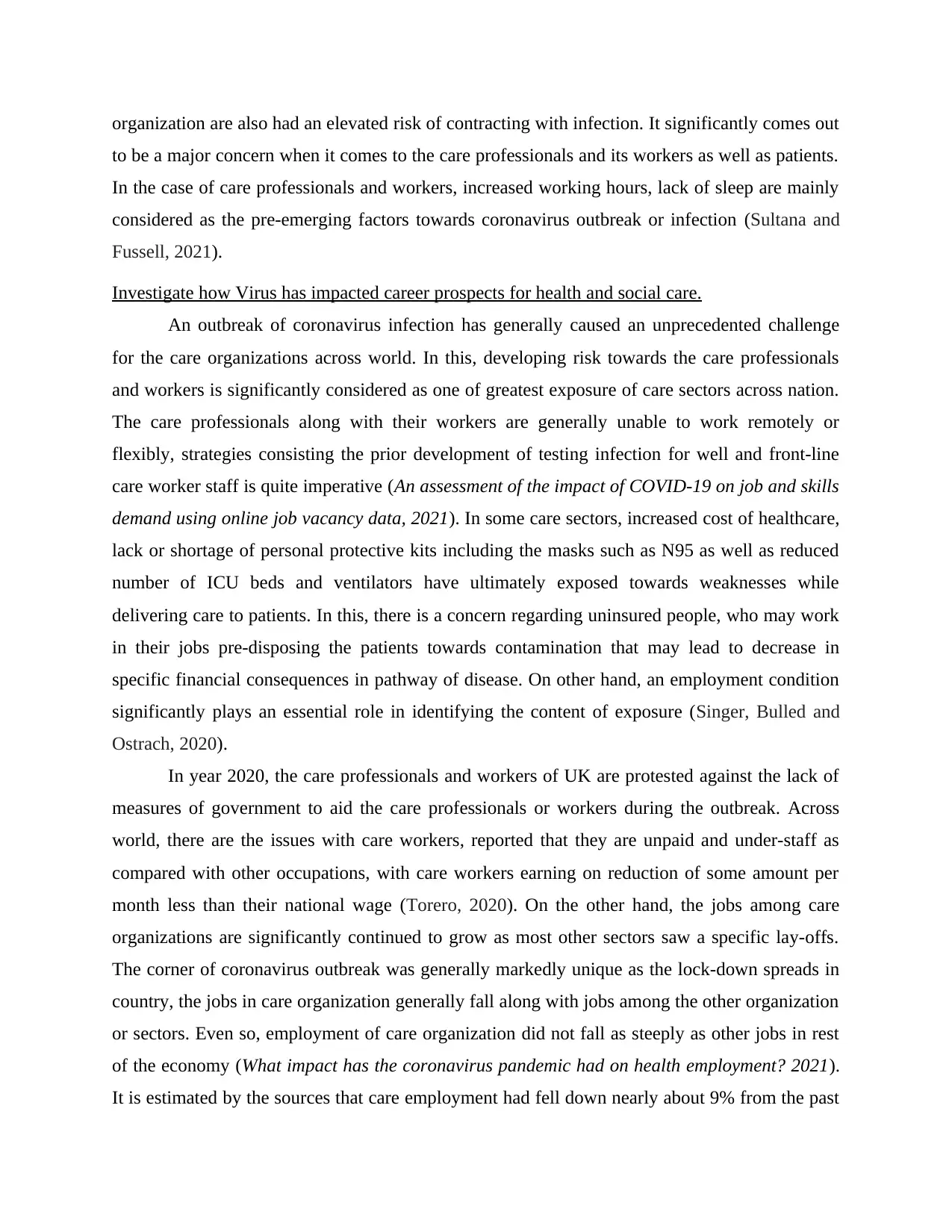
organization are also had an elevated risk of contracting with infection. It significantly comes out
to be a major concern when it comes to the care professionals and its workers as well as patients.
In the case of care professionals and workers, increased working hours, lack of sleep are mainly
considered as the pre-emerging factors towards coronavirus outbreak or infection (Sultana and
Fussell, 2021).
Investigate how Virus has impacted career prospects for health and social care.
An outbreak of coronavirus infection has generally caused an unprecedented challenge
for the care organizations across world. In this, developing risk towards the care professionals
and workers is significantly considered as one of greatest exposure of care sectors across nation.
The care professionals along with their workers are generally unable to work remotely or
flexibly, strategies consisting the prior development of testing infection for well and front-line
care worker staff is quite imperative (An assessment of the impact of COVID-19 on job and skills
demand using online job vacancy data, 2021). In some care sectors, increased cost of healthcare,
lack or shortage of personal protective kits including the masks such as N95 as well as reduced
number of ICU beds and ventilators have ultimately exposed towards weaknesses while
delivering care to patients. In this, there is a concern regarding uninsured people, who may work
in their jobs pre-disposing the patients towards contamination that may lead to decrease in
specific financial consequences in pathway of disease. On other hand, an employment condition
significantly plays an essential role in identifying the content of exposure (Singer, Bulled and
Ostrach, 2020).
In year 2020, the care professionals and workers of UK are protested against the lack of
measures of government to aid the care professionals or workers during the outbreak. Across
world, there are the issues with care workers, reported that they are unpaid and under-staff as
compared with other occupations, with care workers earning on reduction of some amount per
month less than their national wage (Torero, 2020). On the other hand, the jobs among care
organizations are significantly continued to grow as most other sectors saw a specific lay-offs.
The corner of coronavirus outbreak was generally markedly unique as the lock-down spreads in
country, the jobs in care organization generally fall along with jobs among the other organization
or sectors. Even so, employment of care organization did not fall as steeply as other jobs in rest
of the economy (What impact has the coronavirus pandemic had on health employment? 2021).
It is estimated by the sources that care employment had fell down nearly about 9% from the past
to be a major concern when it comes to the care professionals and its workers as well as patients.
In the case of care professionals and workers, increased working hours, lack of sleep are mainly
considered as the pre-emerging factors towards coronavirus outbreak or infection (Sultana and
Fussell, 2021).
Investigate how Virus has impacted career prospects for health and social care.
An outbreak of coronavirus infection has generally caused an unprecedented challenge
for the care organizations across world. In this, developing risk towards the care professionals
and workers is significantly considered as one of greatest exposure of care sectors across nation.
The care professionals along with their workers are generally unable to work remotely or
flexibly, strategies consisting the prior development of testing infection for well and front-line
care worker staff is quite imperative (An assessment of the impact of COVID-19 on job and skills
demand using online job vacancy data, 2021). In some care sectors, increased cost of healthcare,
lack or shortage of personal protective kits including the masks such as N95 as well as reduced
number of ICU beds and ventilators have ultimately exposed towards weaknesses while
delivering care to patients. In this, there is a concern regarding uninsured people, who may work
in their jobs pre-disposing the patients towards contamination that may lead to decrease in
specific financial consequences in pathway of disease. On other hand, an employment condition
significantly plays an essential role in identifying the content of exposure (Singer, Bulled and
Ostrach, 2020).
In year 2020, the care professionals and workers of UK are protested against the lack of
measures of government to aid the care professionals or workers during the outbreak. Across
world, there are the issues with care workers, reported that they are unpaid and under-staff as
compared with other occupations, with care workers earning on reduction of some amount per
month less than their national wage (Torero, 2020). On the other hand, the jobs among care
organizations are significantly continued to grow as most other sectors saw a specific lay-offs.
The corner of coronavirus outbreak was generally markedly unique as the lock-down spreads in
country, the jobs in care organization generally fall along with jobs among the other organization
or sectors. Even so, employment of care organization did not fall as steeply as other jobs in rest
of the economy (What impact has the coronavirus pandemic had on health employment? 2021).
It is estimated by the sources that care employment had fell down nearly about 9% from the past
⊘ This is a preview!⊘
Do you want full access?
Subscribe today to unlock all pages.

Trusted by 1+ million students worldwide
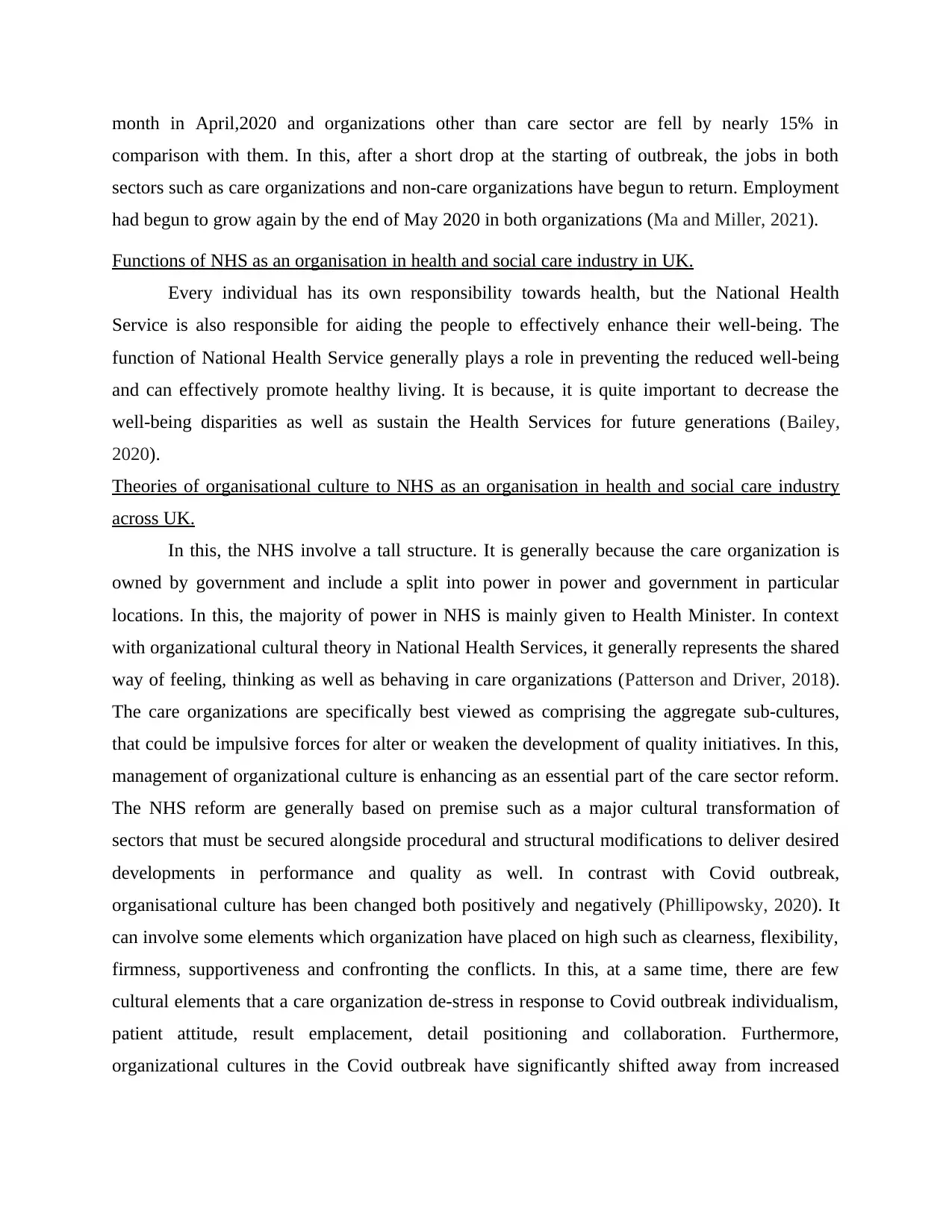
month in April,2020 and organizations other than care sector are fell by nearly 15% in
comparison with them. In this, after a short drop at the starting of outbreak, the jobs in both
sectors such as care organizations and non-care organizations have begun to return. Employment
had begun to grow again by the end of May 2020 in both organizations (Ma and Miller, 2021).
Functions of NHS as an organisation in health and social care industry in UK.
Every individual has its own responsibility towards health, but the National Health
Service is also responsible for aiding the people to effectively enhance their well-being. The
function of National Health Service generally plays a role in preventing the reduced well-being
and can effectively promote healthy living. It is because, it is quite important to decrease the
well-being disparities as well as sustain the Health Services for future generations (Bailey,
2020).
Theories of organisational culture to NHS as an organisation in health and social care industry
across UK.
In this, the NHS involve a tall structure. It is generally because the care organization is
owned by government and include a split into power in power and government in particular
locations. In this, the majority of power in NHS is mainly given to Health Minister. In context
with organizational cultural theory in National Health Services, it generally represents the shared
way of feeling, thinking as well as behaving in care organizations (Patterson and Driver, 2018).
The care organizations are specifically best viewed as comprising the aggregate sub-cultures,
that could be impulsive forces for alter or weaken the development of quality initiatives. In this,
management of organizational culture is enhancing as an essential part of the care sector reform.
The NHS reform are generally based on premise such as a major cultural transformation of
sectors that must be secured alongside procedural and structural modifications to deliver desired
developments in performance and quality as well. In contrast with Covid outbreak,
organisational culture has been changed both positively and negatively (Phillipowsky, 2020). It
can involve some elements which organization have placed on high such as clearness, flexibility,
firmness, supportiveness and confronting the conflicts. In this, at a same time, there are few
cultural elements that a care organization de-stress in response to Covid outbreak individualism,
patient attitude, result emplacement, detail positioning and collaboration. Furthermore,
organizational cultures in the Covid outbreak have significantly shifted away from increased
comparison with them. In this, after a short drop at the starting of outbreak, the jobs in both
sectors such as care organizations and non-care organizations have begun to return. Employment
had begun to grow again by the end of May 2020 in both organizations (Ma and Miller, 2021).
Functions of NHS as an organisation in health and social care industry in UK.
Every individual has its own responsibility towards health, but the National Health
Service is also responsible for aiding the people to effectively enhance their well-being. The
function of National Health Service generally plays a role in preventing the reduced well-being
and can effectively promote healthy living. It is because, it is quite important to decrease the
well-being disparities as well as sustain the Health Services for future generations (Bailey,
2020).
Theories of organisational culture to NHS as an organisation in health and social care industry
across UK.
In this, the NHS involve a tall structure. It is generally because the care organization is
owned by government and include a split into power in power and government in particular
locations. In this, the majority of power in NHS is mainly given to Health Minister. In context
with organizational cultural theory in National Health Services, it generally represents the shared
way of feeling, thinking as well as behaving in care organizations (Patterson and Driver, 2018).
The care organizations are specifically best viewed as comprising the aggregate sub-cultures,
that could be impulsive forces for alter or weaken the development of quality initiatives. In this,
management of organizational culture is enhancing as an essential part of the care sector reform.
The NHS reform are generally based on premise such as a major cultural transformation of
sectors that must be secured alongside procedural and structural modifications to deliver desired
developments in performance and quality as well. In contrast with Covid outbreak,
organisational culture has been changed both positively and negatively (Phillipowsky, 2020). It
can involve some elements which organization have placed on high such as clearness, flexibility,
firmness, supportiveness and confronting the conflicts. In this, at a same time, there are few
cultural elements that a care organization de-stress in response to Covid outbreak individualism,
patient attitude, result emplacement, detail positioning and collaboration. Furthermore,
organizational cultures in the Covid outbreak have significantly shifted away from increased
Paraphrase This Document
Need a fresh take? Get an instant paraphrase of this document with our AI Paraphraser
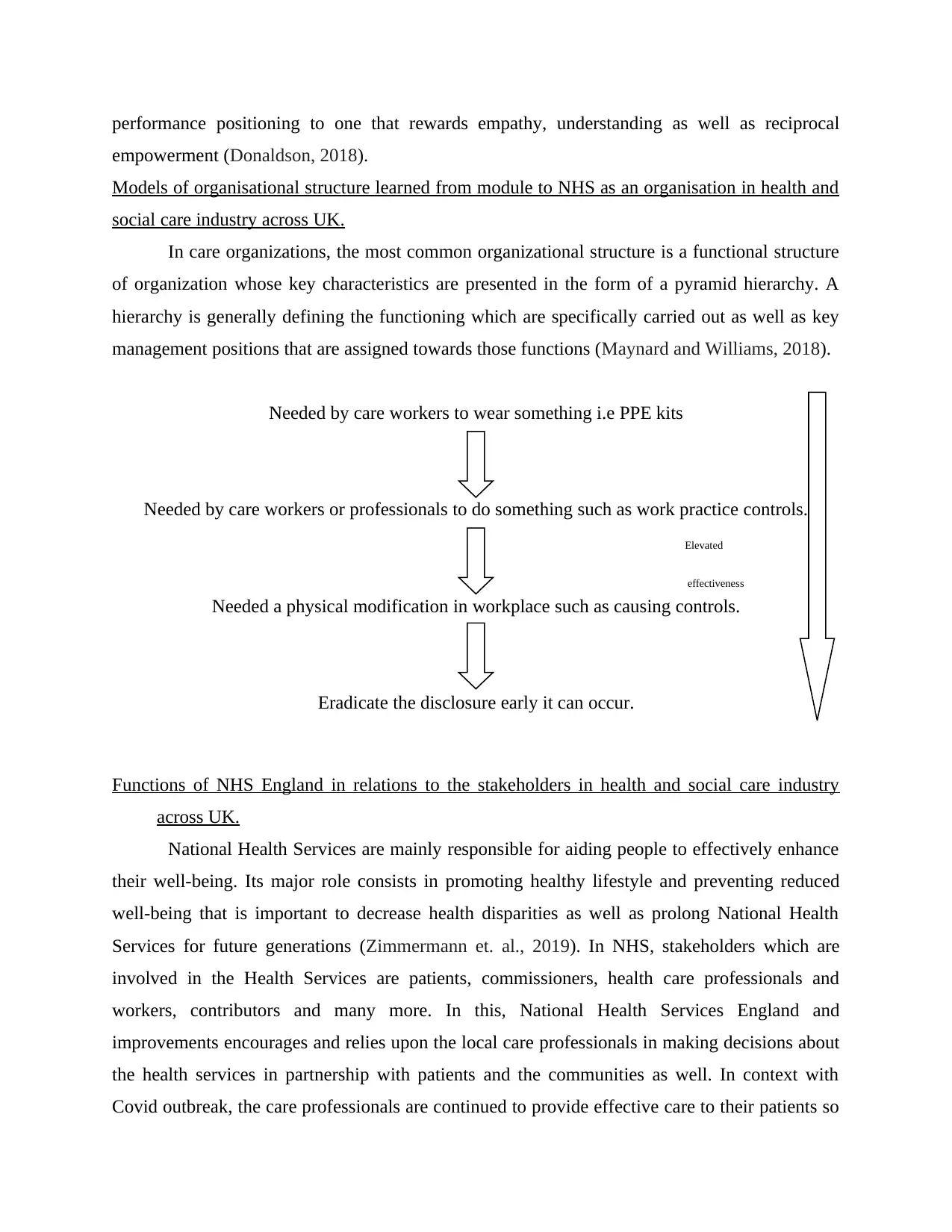
performance positioning to one that rewards empathy, understanding as well as reciprocal
empowerment (Donaldson, 2018).
Models of organisational structure learned from module to NHS as an organisation in health and
social care industry across UK.
In care organizations, the most common organizational structure is a functional structure
of organization whose key characteristics are presented in the form of a pyramid hierarchy. A
hierarchy is generally defining the functioning which are specifically carried out as well as key
management positions that are assigned towards those functions (Maynard and Williams, 2018).
Needed by care workers to wear something i.e PPE kits
Needed by care workers or professionals to do something such as work practice controls.
Needed a physical modification in workplace such as causing controls.
Eradicate the disclosure early it can occur.
Functions of NHS England in relations to the stakeholders in health and social care industry
across UK.
National Health Services are mainly responsible for aiding people to effectively enhance
their well-being. Its major role consists in promoting healthy lifestyle and preventing reduced
well-being that is important to decrease health disparities as well as prolong National Health
Services for future generations (Zimmermann et. al., 2019). In NHS, stakeholders which are
involved in the Health Services are patients, commissioners, health care professionals and
workers, contributors and many more. In this, National Health Services England and
improvements encourages and relies upon the local care professionals in making decisions about
the health services in partnership with patients and the communities as well. In context with
Covid outbreak, the care professionals are continued to provide effective care to their patients so
Elevated
effectiveness
empowerment (Donaldson, 2018).
Models of organisational structure learned from module to NHS as an organisation in health and
social care industry across UK.
In care organizations, the most common organizational structure is a functional structure
of organization whose key characteristics are presented in the form of a pyramid hierarchy. A
hierarchy is generally defining the functioning which are specifically carried out as well as key
management positions that are assigned towards those functions (Maynard and Williams, 2018).
Needed by care workers to wear something i.e PPE kits
Needed by care workers or professionals to do something such as work practice controls.
Needed a physical modification in workplace such as causing controls.
Eradicate the disclosure early it can occur.
Functions of NHS England in relations to the stakeholders in health and social care industry
across UK.
National Health Services are mainly responsible for aiding people to effectively enhance
their well-being. Its major role consists in promoting healthy lifestyle and preventing reduced
well-being that is important to decrease health disparities as well as prolong National Health
Services for future generations (Zimmermann et. al., 2019). In NHS, stakeholders which are
involved in the Health Services are patients, commissioners, health care professionals and
workers, contributors and many more. In this, National Health Services England and
improvements encourages and relies upon the local care professionals in making decisions about
the health services in partnership with patients and the communities as well. In context with
Covid outbreak, the care professionals are continued to provide effective care to their patients so
Elevated
effectiveness
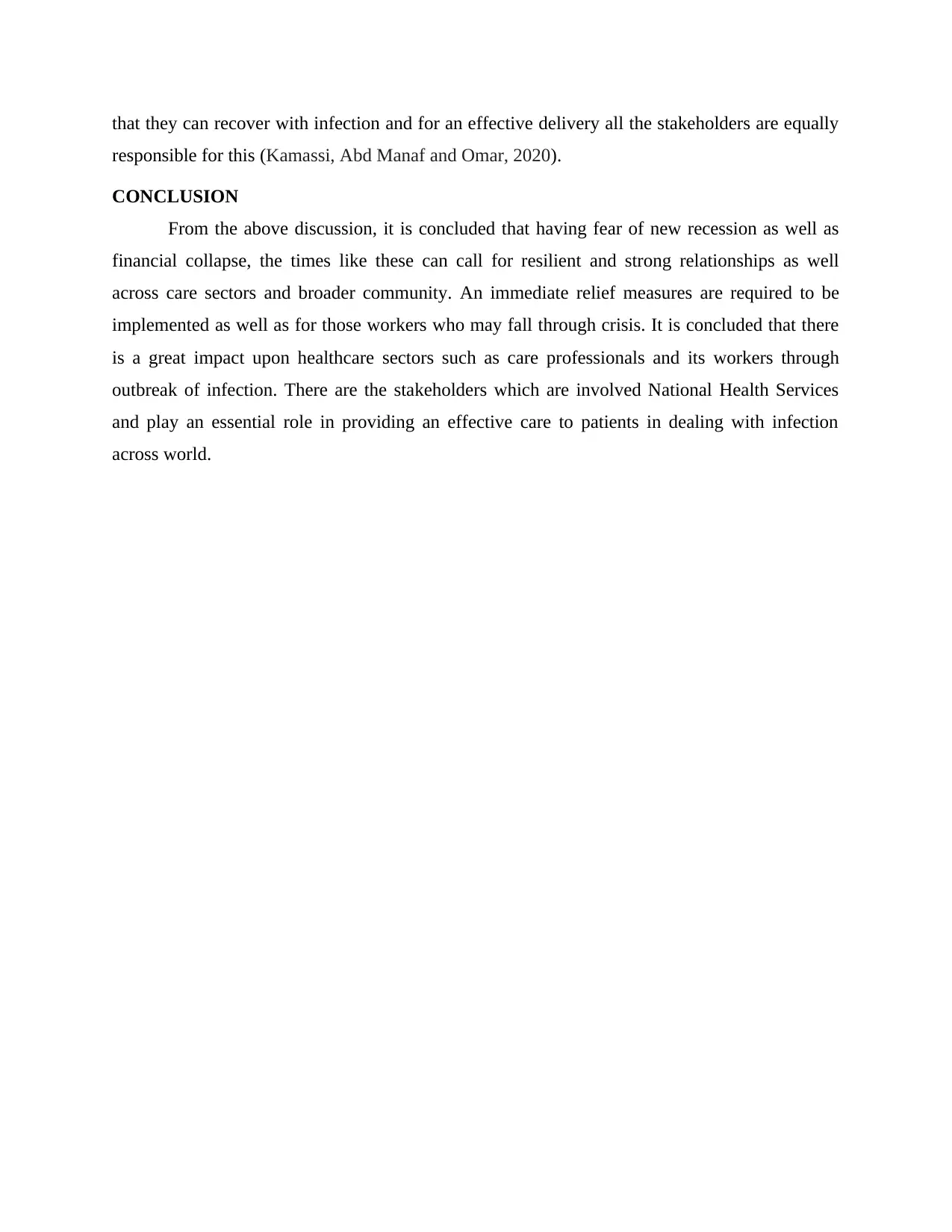
that they can recover with infection and for an effective delivery all the stakeholders are equally
responsible for this (Kamassi, Abd Manaf and Omar, 2020).
CONCLUSION
From the above discussion, it is concluded that having fear of new recession as well as
financial collapse, the times like these can call for resilient and strong relationships as well
across care sectors and broader community. An immediate relief measures are required to be
implemented as well as for those workers who may fall through crisis. It is concluded that there
is a great impact upon healthcare sectors such as care professionals and its workers through
outbreak of infection. There are the stakeholders which are involved National Health Services
and play an essential role in providing an effective care to patients in dealing with infection
across world.
responsible for this (Kamassi, Abd Manaf and Omar, 2020).
CONCLUSION
From the above discussion, it is concluded that having fear of new recession as well as
financial collapse, the times like these can call for resilient and strong relationships as well
across care sectors and broader community. An immediate relief measures are required to be
implemented as well as for those workers who may fall through crisis. It is concluded that there
is a great impact upon healthcare sectors such as care professionals and its workers through
outbreak of infection. There are the stakeholders which are involved National Health Services
and play an essential role in providing an effective care to patients in dealing with infection
across world.
⊘ This is a preview!⊘
Do you want full access?
Subscribe today to unlock all pages.

Trusted by 1+ million students worldwide
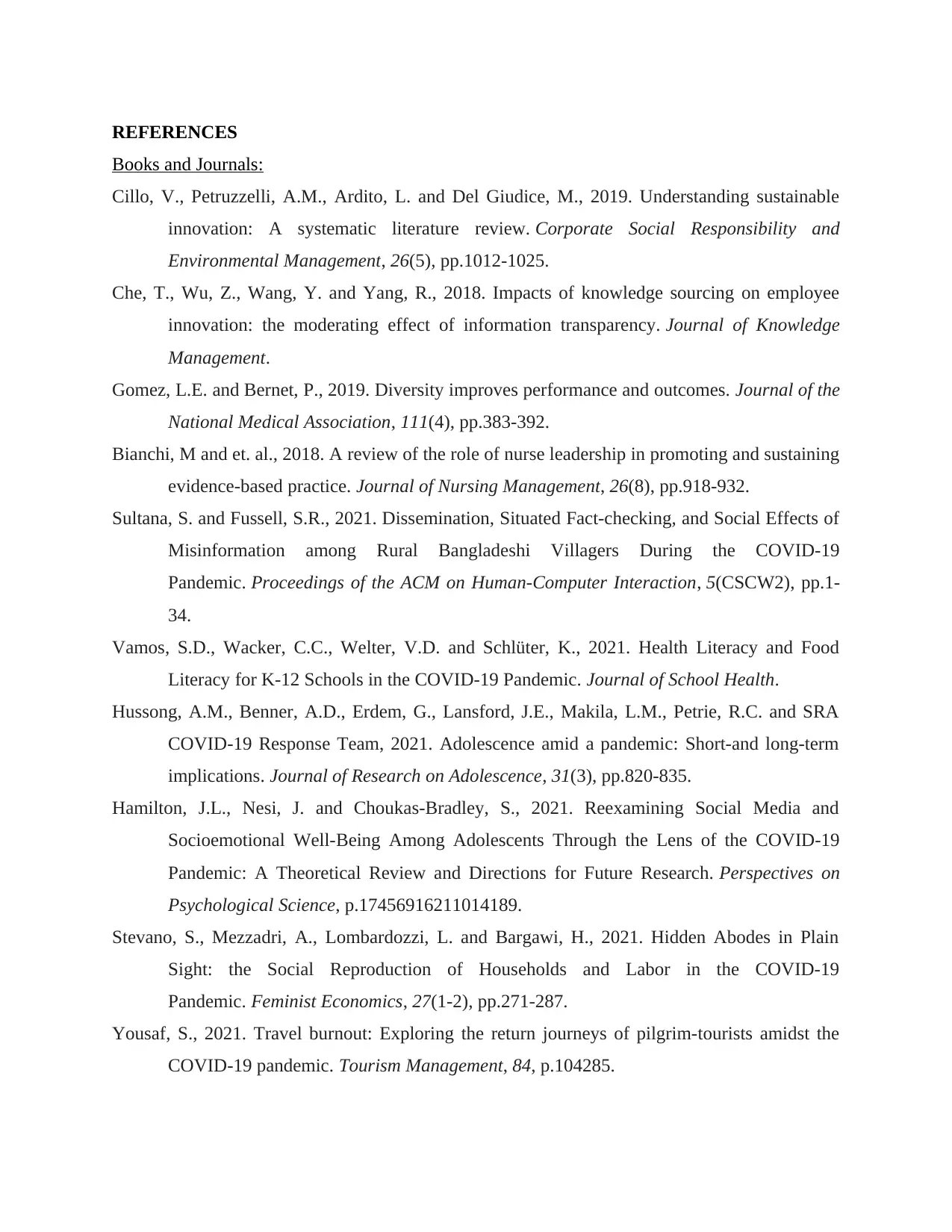
REFERENCES
Books and Journals:
Cillo, V., Petruzzelli, A.M., Ardito, L. and Del Giudice, M., 2019. Understanding sustainable
innovation: A systematic literature review. Corporate Social Responsibility and
Environmental Management, 26(5), pp.1012-1025.
Che, T., Wu, Z., Wang, Y. and Yang, R., 2018. Impacts of knowledge sourcing on employee
innovation: the moderating effect of information transparency. Journal of Knowledge
Management.
Gomez, L.E. and Bernet, P., 2019. Diversity improves performance and outcomes. Journal of the
National Medical Association, 111(4), pp.383-392.
Bianchi, M and et. al., 2018. A review of the role of nurse leadership in promoting and sustaining
evidence‐based practice. Journal of Nursing Management, 26(8), pp.918-932.
Sultana, S. and Fussell, S.R., 2021. Dissemination, Situated Fact-checking, and Social Effects of
Misinformation among Rural Bangladeshi Villagers During the COVID-19
Pandemic. Proceedings of the ACM on Human-Computer Interaction, 5(CSCW2), pp.1-
34.
Vamos, S.D., Wacker, C.C., Welter, V.D. and Schlüter, K., 2021. Health Literacy and Food
Literacy for K‐12 Schools in the COVID‐19 Pandemic. Journal of School Health.
Hussong, A.M., Benner, A.D., Erdem, G., Lansford, J.E., Makila, L.M., Petrie, R.C. and SRA
COVID‐19 Response Team, 2021. Adolescence amid a pandemic: Short‐and long‐term
implications. Journal of Research on Adolescence, 31(3), pp.820-835.
Hamilton, J.L., Nesi, J. and Choukas-Bradley, S., 2021. Reexamining Social Media and
Socioemotional Well-Being Among Adolescents Through the Lens of the COVID-19
Pandemic: A Theoretical Review and Directions for Future Research. Perspectives on
Psychological Science, p.17456916211014189.
Stevano, S., Mezzadri, A., Lombardozzi, L. and Bargawi, H., 2021. Hidden Abodes in Plain
Sight: the Social Reproduction of Households and Labor in the COVID-19
Pandemic. Feminist Economics, 27(1-2), pp.271-287.
Yousaf, S., 2021. Travel burnout: Exploring the return journeys of pilgrim-tourists amidst the
COVID-19 pandemic. Tourism Management, 84, p.104285.
Books and Journals:
Cillo, V., Petruzzelli, A.M., Ardito, L. and Del Giudice, M., 2019. Understanding sustainable
innovation: A systematic literature review. Corporate Social Responsibility and
Environmental Management, 26(5), pp.1012-1025.
Che, T., Wu, Z., Wang, Y. and Yang, R., 2018. Impacts of knowledge sourcing on employee
innovation: the moderating effect of information transparency. Journal of Knowledge
Management.
Gomez, L.E. and Bernet, P., 2019. Diversity improves performance and outcomes. Journal of the
National Medical Association, 111(4), pp.383-392.
Bianchi, M and et. al., 2018. A review of the role of nurse leadership in promoting and sustaining
evidence‐based practice. Journal of Nursing Management, 26(8), pp.918-932.
Sultana, S. and Fussell, S.R., 2021. Dissemination, Situated Fact-checking, and Social Effects of
Misinformation among Rural Bangladeshi Villagers During the COVID-19
Pandemic. Proceedings of the ACM on Human-Computer Interaction, 5(CSCW2), pp.1-
34.
Vamos, S.D., Wacker, C.C., Welter, V.D. and Schlüter, K., 2021. Health Literacy and Food
Literacy for K‐12 Schools in the COVID‐19 Pandemic. Journal of School Health.
Hussong, A.M., Benner, A.D., Erdem, G., Lansford, J.E., Makila, L.M., Petrie, R.C. and SRA
COVID‐19 Response Team, 2021. Adolescence amid a pandemic: Short‐and long‐term
implications. Journal of Research on Adolescence, 31(3), pp.820-835.
Hamilton, J.L., Nesi, J. and Choukas-Bradley, S., 2021. Reexamining Social Media and
Socioemotional Well-Being Among Adolescents Through the Lens of the COVID-19
Pandemic: A Theoretical Review and Directions for Future Research. Perspectives on
Psychological Science, p.17456916211014189.
Stevano, S., Mezzadri, A., Lombardozzi, L. and Bargawi, H., 2021. Hidden Abodes in Plain
Sight: the Social Reproduction of Households and Labor in the COVID-19
Pandemic. Feminist Economics, 27(1-2), pp.271-287.
Yousaf, S., 2021. Travel burnout: Exploring the return journeys of pilgrim-tourists amidst the
COVID-19 pandemic. Tourism Management, 84, p.104285.
Paraphrase This Document
Need a fresh take? Get an instant paraphrase of this document with our AI Paraphraser
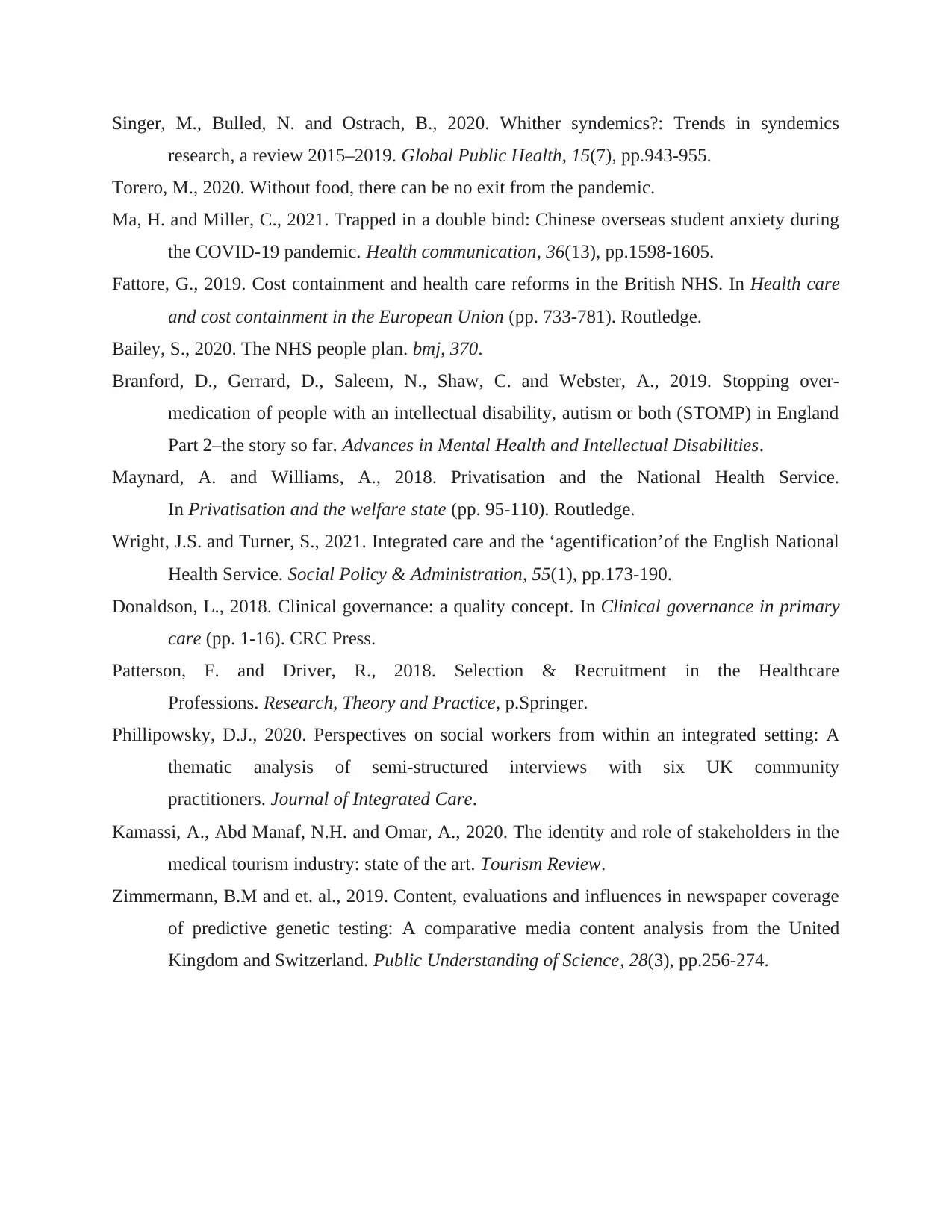
Singer, M., Bulled, N. and Ostrach, B., 2020. Whither syndemics?: Trends in syndemics
research, a review 2015–2019. Global Public Health, 15(7), pp.943-955.
Torero, M., 2020. Without food, there can be no exit from the pandemic.
Ma, H. and Miller, C., 2021. Trapped in a double bind: Chinese overseas student anxiety during
the COVID-19 pandemic. Health communication, 36(13), pp.1598-1605.
Fattore, G., 2019. Cost containment and health care reforms in the British NHS. In Health care
and cost containment in the European Union (pp. 733-781). Routledge.
Bailey, S., 2020. The NHS people plan. bmj, 370.
Branford, D., Gerrard, D., Saleem, N., Shaw, C. and Webster, A., 2019. Stopping over-
medication of people with an intellectual disability, autism or both (STOMP) in England
Part 2–the story so far. Advances in Mental Health and Intellectual Disabilities.
Maynard, A. and Williams, A., 2018. Privatisation and the National Health Service.
In Privatisation and the welfare state (pp. 95-110). Routledge.
Wright, J.S. and Turner, S., 2021. Integrated care and the ‘agentification’of the English National
Health Service. Social Policy & Administration, 55(1), pp.173-190.
Donaldson, L., 2018. Clinical governance: a quality concept. In Clinical governance in primary
care (pp. 1-16). CRC Press.
Patterson, F. and Driver, R., 2018. Selection & Recruitment in the Healthcare
Professions. Research, Theory and Practice, p.Springer.
Phillipowsky, D.J., 2020. Perspectives on social workers from within an integrated setting: A
thematic analysis of semi-structured interviews with six UK community
practitioners. Journal of Integrated Care.
Kamassi, A., Abd Manaf, N.H. and Omar, A., 2020. The identity and role of stakeholders in the
medical tourism industry: state of the art. Tourism Review.
Zimmermann, B.M and et. al., 2019. Content, evaluations and influences in newspaper coverage
of predictive genetic testing: A comparative media content analysis from the United
Kingdom and Switzerland. Public Understanding of Science, 28(3), pp.256-274.
research, a review 2015–2019. Global Public Health, 15(7), pp.943-955.
Torero, M., 2020. Without food, there can be no exit from the pandemic.
Ma, H. and Miller, C., 2021. Trapped in a double bind: Chinese overseas student anxiety during
the COVID-19 pandemic. Health communication, 36(13), pp.1598-1605.
Fattore, G., 2019. Cost containment and health care reforms in the British NHS. In Health care
and cost containment in the European Union (pp. 733-781). Routledge.
Bailey, S., 2020. The NHS people plan. bmj, 370.
Branford, D., Gerrard, D., Saleem, N., Shaw, C. and Webster, A., 2019. Stopping over-
medication of people with an intellectual disability, autism or both (STOMP) in England
Part 2–the story so far. Advances in Mental Health and Intellectual Disabilities.
Maynard, A. and Williams, A., 2018. Privatisation and the National Health Service.
In Privatisation and the welfare state (pp. 95-110). Routledge.
Wright, J.S. and Turner, S., 2021. Integrated care and the ‘agentification’of the English National
Health Service. Social Policy & Administration, 55(1), pp.173-190.
Donaldson, L., 2018. Clinical governance: a quality concept. In Clinical governance in primary
care (pp. 1-16). CRC Press.
Patterson, F. and Driver, R., 2018. Selection & Recruitment in the Healthcare
Professions. Research, Theory and Practice, p.Springer.
Phillipowsky, D.J., 2020. Perspectives on social workers from within an integrated setting: A
thematic analysis of semi-structured interviews with six UK community
practitioners. Journal of Integrated Care.
Kamassi, A., Abd Manaf, N.H. and Omar, A., 2020. The identity and role of stakeholders in the
medical tourism industry: state of the art. Tourism Review.
Zimmermann, B.M and et. al., 2019. Content, evaluations and influences in newspaper coverage
of predictive genetic testing: A comparative media content analysis from the United
Kingdom and Switzerland. Public Understanding of Science, 28(3), pp.256-274.
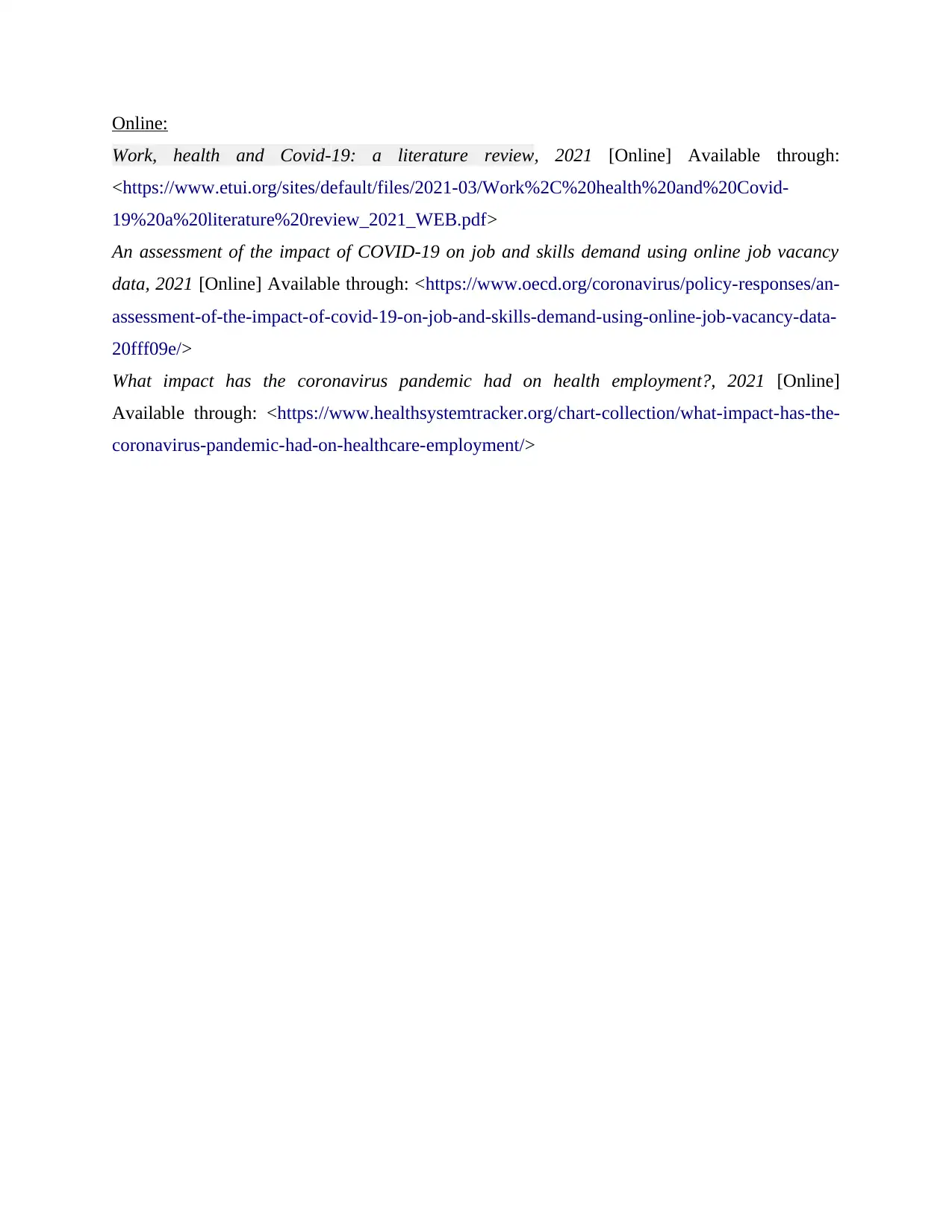
Online:
Work, health and Covid-19: a literature review, 2021 [Online] Available through:
<https://www.etui.org/sites/default/files/2021-03/Work%2C%20health%20and%20Covid-
19%20a%20literature%20review_2021_WEB.pdf>
An assessment of the impact of COVID-19 on job and skills demand using online job vacancy
data, 2021 [Online] Available through: <https://www.oecd.org/coronavirus/policy-responses/an-
assessment-of-the-impact-of-covid-19-on-job-and-skills-demand-using-online-job-vacancy-data-
20fff09e/>
What impact has the coronavirus pandemic had on health employment?, 2021 [Online]
Available through: <https://www.healthsystemtracker.org/chart-collection/what-impact-has-the-
coronavirus-pandemic-had-on-healthcare-employment/>
Work, health and Covid-19: a literature review, 2021 [Online] Available through:
<https://www.etui.org/sites/default/files/2021-03/Work%2C%20health%20and%20Covid-
19%20a%20literature%20review_2021_WEB.pdf>
An assessment of the impact of COVID-19 on job and skills demand using online job vacancy
data, 2021 [Online] Available through: <https://www.oecd.org/coronavirus/policy-responses/an-
assessment-of-the-impact-of-covid-19-on-job-and-skills-demand-using-online-job-vacancy-data-
20fff09e/>
What impact has the coronavirus pandemic had on health employment?, 2021 [Online]
Available through: <https://www.healthsystemtracker.org/chart-collection/what-impact-has-the-
coronavirus-pandemic-had-on-healthcare-employment/>
⊘ This is a preview!⊘
Do you want full access?
Subscribe today to unlock all pages.

Trusted by 1+ million students worldwide
1 out of 12
Related Documents
Your All-in-One AI-Powered Toolkit for Academic Success.
+13062052269
info@desklib.com
Available 24*7 on WhatsApp / Email
![[object Object]](/_next/static/media/star-bottom.7253800d.svg)
Unlock your academic potential
Copyright © 2020–2025 A2Z Services. All Rights Reserved. Developed and managed by ZUCOL.





